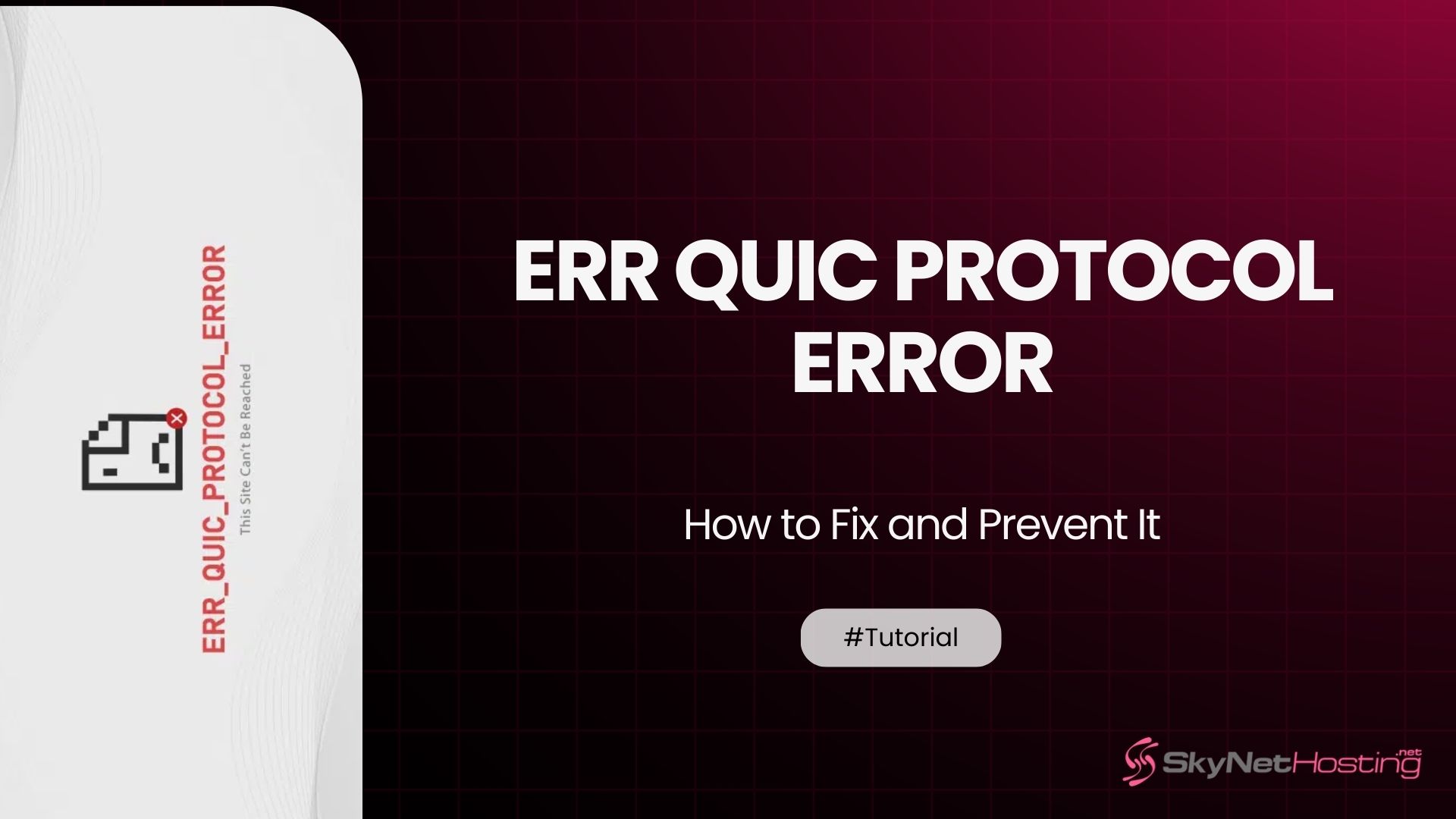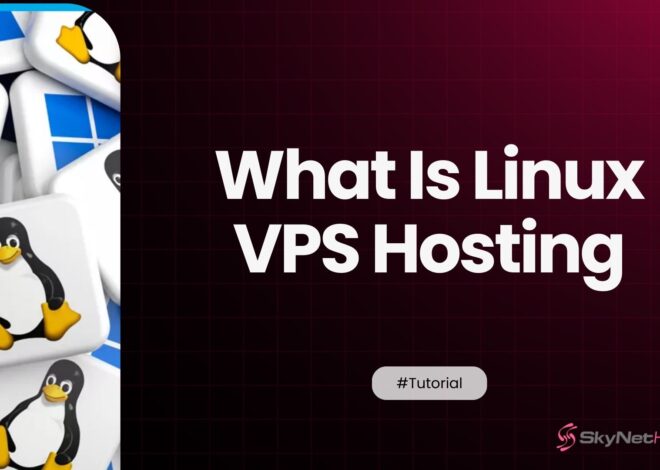
ERR_QUIC_PROTOCOL_ERROR – Meaning, Causes, and How to Fix It
TL;DR
- ERR_QUIC_PROTOCOL_ERROR occurs when the browser (mostly Chrome) fails to connect using the QUIC protocol.
- Causes include browser QUIC bugs, network/DNS conflicts, VPN/proxy interference, firewall blocking, or server misconfiguration.
- Quick fixes: disable QUIC in browser flags, clear cache/cookies/DNS cache, and disable conflicting extensions.
- Proper SSL setup and hosting provider configuration are essential for QUIC support.
- Prevention includes keeping browsers and OS updated, using reliable DNS and hosting, and maintaining valid SSL certificates.
You’re browsing the web when suddenly a page won’t load. Instead, you see “ERR_QUIC_PROTOCOL_ERROR” staring back at you.
Don’t worry. This error is more common than you think. And it’s usually easy to fix.
I’ve been helping website owners solve technical issues for over 10 years. The QUIC protocol error is one I see regularly. The good news? Most fixes take just a few minutes.
In this guide, I’ll walk you through everything you need to know. We’ll cover what causes this error and how to fix it step by step.
What Is ERR_QUIC_PROTOCOL_ERROR?
Definition of the Error
ERR_QUIC_PROTOCOL_ERROR happens when your browser can’t connect to a website using the QUIC protocol.
QUIC stands for Quick UDP Internet Connections. It’s a newer internet protocol that makes websites load faster.
Think of it like a highway for data. Sometimes there’s a roadblock. When that happens, your browser shows this error.
The error usually appears in Google Chrome. But other browsers can show similar messages too.
How QUIC Protocol Works in Browsers
QUIC is Google’s attempt to speed up the internet.
Traditional websites use TCP connections. QUIC uses UDP instead. This makes connections faster and more reliable.
Here’s the simple version: QUIC reduces the back-and-forth between your browser and the website. Fewer steps mean faster loading.
Chrome enables QUIC by default. That’s why you see this error more often in Chrome than other browsers.
Why Does ERR_QUIC_PROTOCOL_ERROR Occur?
Let me break down the main causes. Understanding why helps you fix it faster.

Browser QUIC Protocol Issues
Sometimes Chrome’s QUIC implementation gets stuck.
This happens when:
- Chrome updates break QUIC support
- Browser cache conflicts with QUIC data
- Extensions interfere with protocol handling
I’ve seen this happen after major Chrome updates. The browser tries to use QUIC but something goes wrong.
Network or DNS Conflicts
Your internet connection might not play nice with QUIC.
Common network issues include:
- Router firmware blocking QUIC traffic
- ISP throttling or blocking UDP connections
- DNS servers not resolving QUIC properly
Some corporate networks block QUIC entirely. They prefer traditional connections for security reasons.
VPN and Proxy Interference
VPNs and proxies often cause QUIC errors.
Here’s why: Many VPN services don’t support QUIC protocol. They’re designed for older connection types.
When Chrome tries to use QUIC through a VPN, the connection fails. The VPN server doesn’t know what to do with QUIC requests.
Antivirus or Firewall Blocking
Security software can be overly protective.
Some antivirus programs see QUIC as suspicious. They block it to “protect” you. This causes the protocol error.
Windows Firewall sometimes does this too. Especially on corporate computers with strict security settings.
Hosting or SSL Configuration Problems
Website servers can cause QUIC errors too.
This happens when:
- The server doesn’t support QUIC properly
- SSL certificates conflict with QUIC
- Server configuration blocks QUIC connections
As a hosting expert, I see this often. Not all hosting providers configure QUIC correctly.
How to Fix ERR_QUIC_PROTOCOL_ERROR in Chrome?
Let’s start with the simplest fixes. Try these in order.

Disable QUIC Protocol in Chrome Settings
This is the quickest fix. Here’s how:
- Type
chrome://flagsin your address bar - Search for “quic”
- Find “Experimental QUIC protocol”
- Set it to “Disabled”
- Restart Chrome
This tells Chrome to stop using QUIC. Your browser will use traditional connections instead.
The website should load normally now.
Clear Cache, Cookies, and DNS Cache
Corrupted data causes many browser issues.
Clear Chrome Data:
- Press Ctrl+Shift+Delete (or Cmd+Shift+Delete on Mac)
- Select “All time” from the dropdown
- Check “Cookies and other site data”
- Check “Cached images and files”
- Click “Clear data”
Clear DNS Cache:
- Press Windows key + R
- Type
cmdand press Enter - Type
ipconfig /flushdnsand press Enter - Restart your browser
This removes old connection data that might conflict with QUIC.
Check Browser Extensions and Remove Conflicts
Extensions can interfere with QUIC protocol.
Test in Incognito Mode:
- Press Ctrl+Shift+N to open incognito
- Try loading the website
- If it works, an extension is causing the problem
Disable Extensions:
- Type
chrome://extensionsin address bar - Turn off extensions one by one
- Test the website after each disable
- Remove the problematic extension
Ad blockers and VPN extensions often cause QUIC issues.
Reset Chrome Browser Settings
If nothing else works, reset Chrome completely.
Warning: This removes all your settings and extensions.
- Go to Chrome Settings
- Click “Advanced” at the bottom
- Click “Reset and clean up”
- Select “Restore settings to original defaults”
- Click “Reset settings”
This puts Chrome back to factory settings. QUIC will work if the issue was configuration-related.
How to Fix ERR_QUIC_PROTOCOL_ERROR on Other Browsers?
Chrome isn’t the only browser that uses QUIC.
Microsoft Edge Troubleshooting
Edge uses similar QUIC settings to Chrome.
Disable QUIC in Edge:
- Type
edge://flagsin address bar - Search for “quic”
- Disable experimental QUIC protocol
- Restart Edge
Clear Edge Data:
- Press Ctrl+Shift+Delete
- Select all data types
- Choose “All time”
- Click “Clear now”
Edge shares some code with Chrome. So most Chrome fixes work here too.
Firefox Protocol Error Fixes
Firefox handles QUIC differently.
Check Firefox QUIC Settings:
- Type
about:configin address bar - Search for
network.http.http3.enabled - Set to
falseif it’strue - Restart Firefox
Firefox calls QUIC “HTTP/3.” Disabling HTTP/3 stops QUIC errors.
How Do Network and Hosting Providers Help Solve ERR_QUIC_PROTOCOL_ERROR?
Sometimes the problem isn’t on your end.
Role of DNS and Hosting Settings
Your hosting provider controls server-side QUIC support.
Good hosting companies like SkynetHosting.net configure QUIC properly. They ensure:
- Servers support QUIC protocol
- SSL certificates work with QUIC
- Network routing handles QUIC traffic
Bad hosting providers don’t configure QUIC at all. This causes errors for visitors.
Fixing SSL and HTTPS Issues with Hosting Providers
QUIC requires proper SSL setup.
Common SSL Problems:
- Expired certificates
- Wrong certificate chain
- Mixed HTTP/HTTPS content
These issues break QUIC connections. Visitors see protocol errors instead of your website.
When to Contact Your Web Host (SkynetHosting.net Support)
Contact your hosting provider if:
- Multiple users report the same error
- The error only happens on your website
- Browser fixes don’t work
At SkynetHosting.net, we check server logs to diagnose QUIC issues. Our support team can:
- Verify QUIC configuration
- Fix SSL certificate problems
- Adjust server settings for better QUIC support
We’ve helped thousands of website owners solve protocol errors. Most issues get resolved within hours.
How Can Users Prevent ERR_QUIC_PROTOCOL_ERROR in the Future?
Prevention is better than fixing.
Keep Browser and OS Updated
Old software causes compatibility issues.
Update Chrome Regularly:
- Chrome updates automatically
- Check for updates in Chrome Settings
- Restart Chrome after updates
Update Your Operating System:
- Windows updates include network fixes
- Mac updates improve browser compatibility
- Linux users should update network packages
New updates often fix QUIC bugs.
Use Reliable DNS and Hosting Services
Your internet provider affects QUIC performance.
Choose Better DNS Servers:
- Google DNS: 8.8.8.8 and 8.8.4.4
- Cloudflare DNS: 1.1.1.1 and 1.0.0.1
- OpenDNS: 208.67.222.222 and 208.67.220.220
Pick QUIC-Compatible Hosting:
Quality hosting providers support modern protocols. SkynetHosting.net includes:
- Full QUIC protocol support
- Properly configured SSL certificates
- 24/7 technical support for protocol issues
Ensure SSL Certificates Are Configured Properly
Website owners need valid SSL certificates for QUIC.
SSL Best Practices:
- Use certificates from trusted authorities
- Keep certificates up to date
- Configure proper certificate chains
- Test SSL setup regularly
Tools like SSL Labs can check your certificate setup.
ERR_QUIC_PROTOCOL_ERROR vs Other Browser Errors
Let me clarify how QUIC errors differ from other common browser problems.
ERR_SSL_PROTOCOL_ERROR
SSL errors affect secure connections in general. QUIC errors are specific to the QUIC protocol.
Key Differences:
- SSL errors happen on any secure site
- QUIC errors only happen when QUIC is enabled
- SSL errors show certificate problems
- QUIC errors show connection problems
ERR_CONNECTION_TIMED_OUT
Timeout errors mean your browser gave up waiting. QUIC errors mean the connection method failed.
Connection timeout causes:
- Slow internet connection
- Server overload
- Network congestion
QUIC error causes:
- Protocol incompatibility
- Firewall blocking
- Configuration problems
NET::ERR_CERT_AUTHORITY_INVALID
Certificate authority errors affect trust. QUIC errors affect connection speed.
This error means your browser doesn’t trust the website’s SSL certificate. It’s a security issue, not a protocol issue.
Quick Recap and Prevention Tips
ERR_QUIC_PROTOCOL_ERROR sounds scary but it’s usually simple to fix.
Quick Fixes:
- Disable QUIC in browser settings
- Clear browser cache and cookies
- Check for extension conflicts
- Reset browser if needed
Prevention Steps:
- Keep browsers updated
- Use reliable hosting providers
- Maintain proper SSL certificates
- Choose compatible DNS servers
Why Choosing a Reliable Hosting Provider Like SkynetHosting.net Prevents Protocol Errors
The right hosting provider makes all the difference.
At SkynetHosting.net, we’ve been solving hosting issues for over 20 years. Our servers support modern protocols like QUIC out of the box.
What We Provide:
- Pre-configured QUIC support
- Properly installed SSL certificates
- 24/7 expert technical support
- Regular server updates and maintenance
We serve over 700,000 websites across 25 worldwide locations. Our customers rarely see protocol errors because we handle the technical details.
Our QUIC Advantages:
- NVMe storage for faster QUIC connections
- LiteSpeed web servers optimized for QUIC
- Advanced caching that works with modern protocols
- Expert support team familiar with protocol issues
When you choose quality hosting, you prevent problems before they start. Your visitors get fast, reliable connections without protocol errors.
Ready to eliminate hosting-related protocol errors? Contact our support team at SkynetHosting.net. We’ll help you set up hosting that works perfectly with modern browser protocols.
FAQs
Why is steady monthly income better than one-time earnings?
Monthly income provides predictable cash flow and financial stability, making it easier to plan and grow a business. Recurring payments help avoid the stress of inconsistent earnings and enable long-term scaling, compared to the unpredictability of one-time transactions.
Which affiliate programs offer recurring commissions?
Affiliate programs linked to subscription-based services such as SaaS tools, web hosting providers, online courses, and marketing platforms typically pay monthly recurring commissions. This creates reliable income as long as your referrals continue to maintain active subscriptions.
How do membership sites generate ongoing monthly income?
Membership sites generate steady income by providing exclusive content, tutorials, and community access behind a paywall. Members pay monthly for continuous value, fostering ongoing engagement and high retention, which results in reliable income for creators serving niche audiences.
What are subscription boxes and digital products?
Subscription boxes include curated physical or digital products delivered to customers monthly. Digital products such as e-books, templates, graphics, and audio content can also be sold on a subscription basis, offering scalable and predictable recurring income streams for creators.
How do freelancers benefit from retainer clients?
Freelancers with retainer clients gain stable contracts and recurring payments by providing ongoing services such as website maintenance, SEO, and content creation. This reduces the uncertainty of finding new projects frequently and helps build predictable monthly income.
What makes reseller hosting a reliable monthly income stream?
Reseller hosting is reliable because web hosting is a constant need for businesses. The model provides built-in recurring payments, low startup costs, high profit margins, and automated billing processes through tools like WHMCS, ensuring stable and scalable income.
What features make Skynethosting.net ideal for reseller hosting?
Skynethosting.net offers a free WHMCS license, domain reseller account, fast NVMe SSD storage, 24/7 client support, competitive pricing starting at $6.95/month, and twenty years of experience, making it easy to launch and grow a hosting business efficiently.
About the Author: Elias Vance is a Senior Infrastructure Engineer with over 15 years of experience in managing high-performance web servers and data center operations. He specializes in optimizing hosting environments for speed, security, and scalability. A passionate advocate for efficient web technology, Elias leverages his deep technical expertise to help businesses and developers build faster, more reliable online platforms, including robust virtualization environments.



